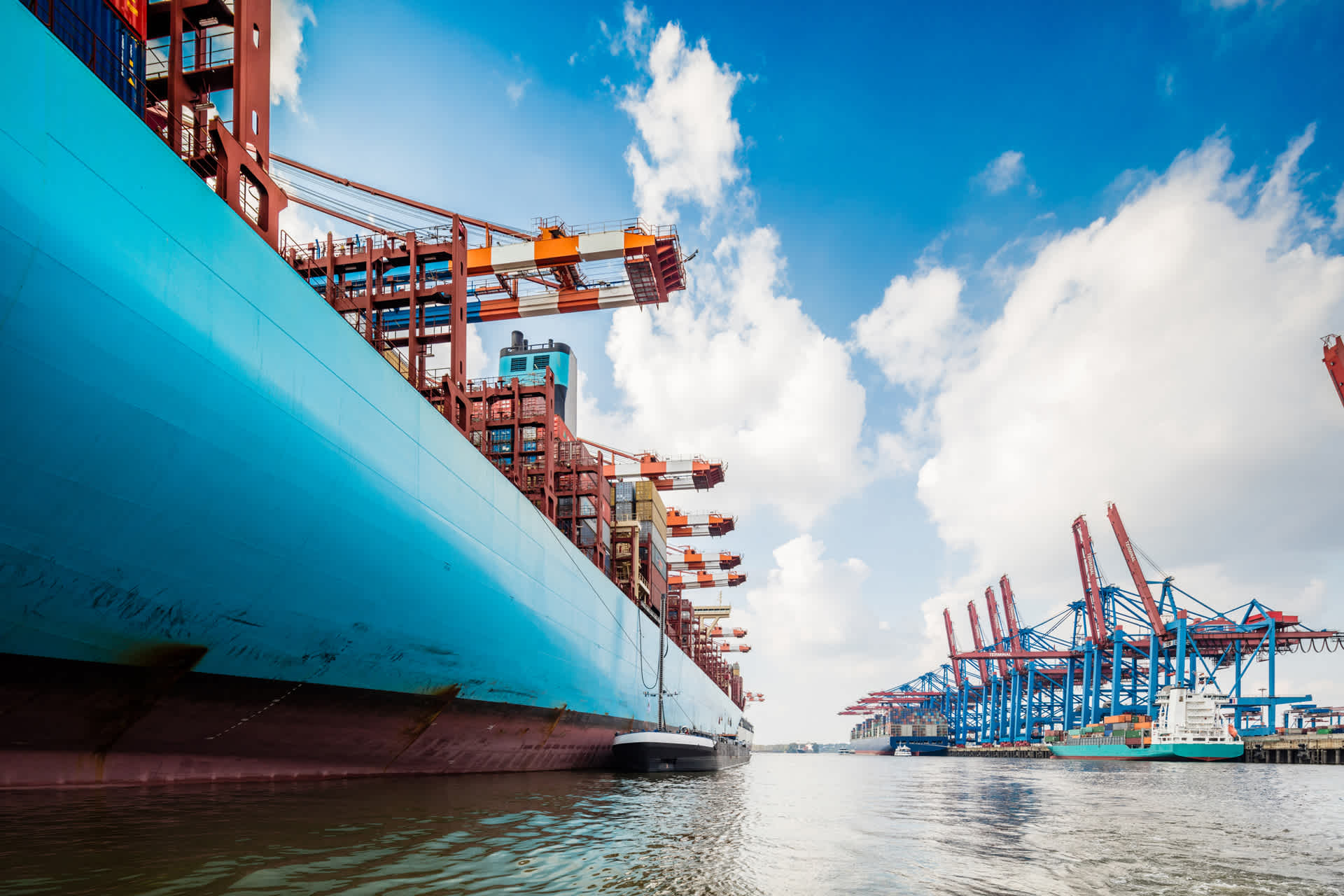Global Logistics Update
Freight Market Update: October 19, 2021
Ocean and air freight rates and trends; customs and trade industry news plus Covid-19 impacts for the week of October 19, 2021.
Freight Market Update: October 19, 2021
FORWARD 2021, a Virtual Event | October 19 to 21
Join us for FORWARD 2021, happening this week. We’re bringing together logistics pros, technologists, and trade veterans to unlock supply chains and shape the future of global trade.
Flexport Surveyed 100 Exporters on Electricity Ration Impacts See the results here.
Ocean Freight Market Update
Asia → North America (TPEB)
- Premium and extra loader market softens due to dips in demand for the most expensive space on TPEB. Whether rates will continue to flatten, further reduce, or even increase remains unclear. Carriers have indicated that the demand outlook remains strong through the end of the year. This is in line with projections by economists, indicating strong forecasts until inventories replenish. Congestion is expected to remain severe.
- Rates Carriers extended or even reduced rates as of 2H October. Rate levels remain elevated.
- Space Critical
- Capacity/Equipment Critical/Severe Undercapacity
- Recommendation Continue to book well in advance (at least 4 to 6 weeks) from CRD to target ETD for best chance of hitting timelines.
Asia → Europe (FEWB)
- Space and equipment crunches continue. Market demand is consistently exceeding supply, and rates have been very high for a long period. The overall space situation is worsened by blank sailings and poor equipment availability. Carriers are overcommitted and are limiting booking acceptance or rolling shipments. With continuous vessel delays and shifts, schedule reliability is very low. Power shortages are affecting factory production up to a certain extent and causing more changes in shipping plans.
- Rates Rates remain at a record high level, but have been reasonably stable throughout October. Most carriers have extended their premium rates.
- Space Extremely critical space situation
- Capacity/Equipment Severe equipment shortage across all Asia origins.
- Recommendation Book at least 4 to 5 weeks prior to CRD. Consider premium options, which may be limited. Be flexible in regard to equipment.
Europe → North America (TAWB)
- Terminal congestion along the US East Coast is now impacting vessel schedules with some lines cancelling Savannah calls and replacing them with Charleston or Jacksonville. Congestion at LAX/LGB is also causing lines to now omit both ports and impacting schedules.
- Rates GRI October 1 implemented. Rates will stay strong for all Q4 2021
- Space Critical
- Capacity/Equipment Capacity remains tight for both North Europe and Mediterranean services. Better equipment availability at port; shortages remain at inland depots.
- Recommendation: Book 5 or more weeks prior to CRD. Request premium service for higher reliability and no-roll guarantees.
Indian Subcontinent → North America
- Forward-looking rates soften as strong demand, equipment deficits, and port omissions continue to challenge the Indian Subcontinent.
- Rates soften with no expected increases through end of October
- Space remains a challenge as global congestion results in omissions and altered sailing schedules. LA/LB and Savannah are of the greatest concern for the Indian Subcontinent market.
- Equipment of all types are in deficit. Carriers are working to reposition empties while also placing large orders of new equipment.
- Recommendation Use premiums on urgent shipments and shipments with CRD approaching. If routing to USWC, consider rerouting to USEC. Be flexible with inland container depot (ICD) location and equipment type.
North America → Asia
- Vessel arrivals and available capacity remain fluid for USWC POLs. USEC capacity has been more readily available; Deteriorating schedule integrity in addition to creating void sailings and delays is creating significant challenges with posted earliest return dates and vessel cut-offs at the port.
- Rates Multiple GRIs announced for dry and reefer cargoes for Nov 1, expected to be implemented
- Equipment Deficits on containers and chassis are still plaguing IPI origins. Availability for standard equipment at ports has not been an issue, but any special equipment is hard to come by.
- Recommendation Please place bookings 4 to 6 weeks in advance to secure your equipment and vessel space.
North America → Europe
- There is available capacity on the TAEB trade with carriers looking for cargo from the US East and Gulf Coasts. US West Coast service to Europe is extremely tight and one service will be suspending their Seattle port of call for much of Q4. There are 3 TAEB services that will be omitting Savannah and calling Charleston or Jacksonville instead due to the significant congestion issues at the port.
- Rates to remain steady for October.
- Equipment Deficits are still plaguing IPI origins. Availability for standard equipment at ports has not been an issue, but any special equipment is hard to come by.
- Please place bookings 3 to 4 weeks in advance for East Coast/Gulf sailings and 6 weeks for Pacific Coast sailings.
Air Freight Market Update
Asia
- N.China: Due to the increase in demand, TPEB rates have also begun increasing. PVG airport is still experiencing some operational handling issues which will likely impact peak volume. FEWB rates are relatively stable, however FRA terminal congestion is expected to continue for another two weeks and is also starting to impact the AMS terminal.
- S. China: Demand and rates ex-South China continue to increase for both TPEB and FEWB lanes. HKG-US capacity is full for the week with ocean conversions still prevalent in the market.
- Taiwan: The market is tight with strong demand for the remainder of the month. Standard service on TPEB lanes are full until Oct 26; expect booking delays of around 5 to 7 days. FEWB standard service is also seeing similar congestion delays at origin with the majority of space full until 10/28. Transit times overall may vary and are subject to cargo dimensions, package type, and density. Due to the continued strong FEWB demand, Cargolux, a major provider on the FEWB lane, recently updated their cancellation policy.
- SE Asia: The BKK market situation continues to be very tight with some carriers only able to accept palletized cargo to LAX/JFK in mid-Nov; loose cartons are preferable in the market. FEWB rates have increased as many of the airlines are overbooked and the remaining capacity is very limited. Terminal operations ex-Northern Vietnam are extremely congested due to the high amount of air volume. All the airlines are overbooked, especially to ATL, JFK, and FRA. FEWB rates will continue to climb until the end of November. Demand ex-Southern Vietnam is still increasing. TPEB rates remain at similar levels to the previous week. FEWB demand, in particular, has increased significantly and space is full for the week. The rate level has also jumped quite a bit. We recommend placing bookings at least a week in advance.
Europe
- Demand still steady WoW ex EU. Rates fell slightly due to the re-introduction of capacity on the TransAtlantic. Secondary hubs like DTW are an attractive solution if lead time allows. There are also some deferred capacity options in the market keeping capacity stable for current demand. Expect market stability to continue through October.
- Very heavy strain on import terminals AMS and FRA. Building in extra lead time is vital at destination, as this disruption is expected to persist for the remainder of Q4. Export terminals are also facing strain. At AMS, trucks are waiting a number of hours to unload their export cargo, in some cases being turned away to the following day, risking missing Latest Acceptance Times (LAT).
- Far East Eastbound rates have increased since last week; however, ample capacity remains on this trade lane
- Advice continues for all trade lanes ex EU: Place bookings at least 7 days ahead of CRD for most optimal rates and routing solutions.
Americas
- US Export demand is increasing in the second half of October. Larger shipments from major outbound gateways can take 2 to 4 days from booking to uplift into the EU, LATAM, or Asia.
- LAX/ORD/JFK ground handlers continue to face large backlogs and are using off-airport facilities to manage the flood of inbound cargo, which has a trickle-down effect on the export side. Many have shortened their free time for storage, and have implemented new, earlier close outs for exports to accommodate longer throughput times and screening requirements.
- Rates haven’t experienced any significant changes compared to the previous week.
- Slightly higher transit times into top European hubs due
- to their current labor shortage, and high throughput time.
- Recommendation Book early considering the dwell time at airports.
Updates from Flexport's Customs & Compliance Team
CBP Proposes New Marking Rules for Medical Devices
In the October 13 Bulletin (page 12), CBP proposes to change two rulings on country of origin marking of different medical device kits with parts from varying countries of origin. CBP is proposing that the kits must be marked to specify the country of origin of each individual component, if not substantially transformed as a result of its inclusion in the kit. CBP requests that comments be submitted electronically on or before November 12, 2021.
CBP Requests Importers Not Cancel Entries Potentially Impacted by Section 301 Exclusions
CBP recently reiterated that importers cannot cancel entries due to potential Section 301 applicability. They specifically stated “Importers cannot cancel entries filed to take advantage of pending or potential decreases in Section 301 duties and/or approval/extension of exclusions in violation of the applicable regulations.” Only in limited circumstances can importers cancel entries.
CBP Introduces New Bill Form in ACE
CBP will deploy a new bill form in ACE to allow for the option to electronically view certain bills. Users can view “unpaid, open bills starting at the time that physical bills are created until the bills are paid.” The new bill format will give users more information regarding the bill itself and other insights surrounding the bill. The new format will be effective October 18, 2021.
Factory Output News
Taiwan Eva Airways is ordering new cargo planes in response to strong demand for air cargo shipping [Source]
Vietnam Factories struggling with shortage of manpower [Source]
Singapore Singapore exports rose by 12.3% for 10 months consecutively. Electronics exports rose by 14.4%, and non-electronics shipments rose by 11.7%. [Source]
India Air India will increase flight frequency to Chicago from 6 days a week to 7 days a week. [Source]
India US has overtaken China as India’s largest trading partner. In the first 9 months of 2021, two-way trade between India and US jumped 50% to $28B while trade with China rose 46% to $25.3B [Source]
Bangladesh Bangladesh now has the highest number of green garment factories in the world [Source]
Freight Market News
Global Ports Facing Intense Congestion According to Bloomberg, the Port of Savannah led all major ports on Thursday with an 81% congestion rate, while LA and Long Beach had a combined 56% congestion rate on Friday. It’s estimated that 77% of ports globally are experiencing congestion heading into the holiday season.
Read More: Transpacific Shifts: Import Demand Is Changing the World’s Busiest Trade Lane
Imbalanced Trucking Demand in LA Spot rates are currently nearly 3 times more expensive to move east to west, contributing to the shortage of truckload capacity on the West Coast. FreightWaves reports outbound demand is outpacing inbound by 43% in LA, creating the shortage as too much freight exits the west and not enough returns.
Economic highlights from Flexport Chief Economist Dr. Phil Levy
Power Crisis Increases Pressure to Supply Chains Electric power limitations in China may bring additional disruption to supply chains. The Loadstar reports the scenario could reduce manufacturing output, leading to lower export volumes, longer lead times, and prioritization of high-value goods.
In Europe, industrial power users cut demand by 12% in the first half of October versus the same period of 2019 on higher prices. Coal India has restricted coal sales to steel buyers to keep the lights on.
Read More: Flexport Survey: Electricity Rationing Impacts to Supply Chains
China Announces Slow GDP Growth of just 4.3% in Q3. This was down from 7.9% year-over-year growth in Q2. As one contributing factor, industrial output grew by 3.1% in September y-o-y, down from 5.3% in August and below expectations.
China Trade Grows Significantly International merchandise trade activity increased by 23.3% YOY in September. Exports accelerated to 28.1% from 25.6% a month earlier, beating analysts’ 21.0% expectations. Higher commodity prices were a major driver, while exports of telecoms equipment jumped 70% higher after dropping 25% a month earlier.
September US Retail Sales Climb by 0.7% over August, whereas predictions had called for a drop.
US Prices Shoot Up. The Consumer Price Index (CPI) rose by 5.4% over the 12 months to September. Excluding food and energy, the index rose by 4.0%. The Producer Price Index (PPI) rose by 8.6% over the same period, the largest such increase in the history of the index. One-year inflation expectations reached 5.3%, also a series high.
Brexit Negotiations Continue. The EU issued its response to UK demands to relax trade rules between the mainland U.K. and Northern Ireland. The UK has said it doesn’t go far enough.
Freight Market Update is a complimentary service from Flexport, the modern freight forwarder. If you're not already a subscriber, we invite you to subscribe here.
Please note that the information in our publications is compiled from a variety of sources based on the information we have to date. This information is provided to our community for informational purposes only, and we do not accept any liability or responsibility for reliance on the information contained herein.


